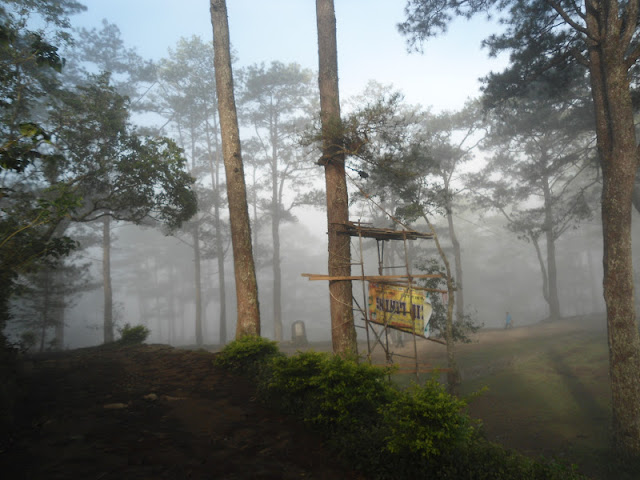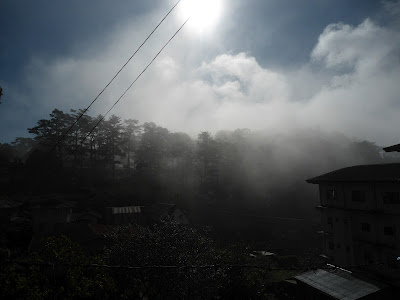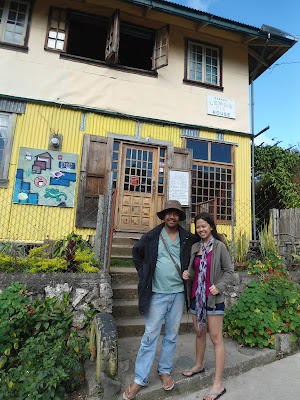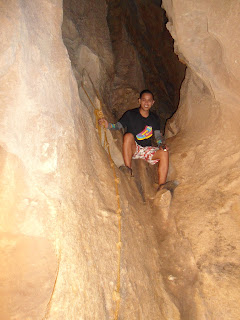[Feb 24-25, 2012]
" It's not about how you capture a scenery--it's about how the scenery captures you."
Really. For an island girl like me, this place is just............pure heaven.
And yes --we're still in the Philippines. Surprise! It's like a winter morning without snow.
But before I get carried away, this is the last part of our very very short Sagada Trip.
Less than 24 hours to be exact.
Since we had a very limited time, we had to make sure that we don't miss
trekking to Echo Valley and find out why it was named as such.
When we woke up on our second/last day in Sagada, it was just FOG everywhere!
Our windows were filled with mist and it seemed very dark outside though it was nearly 7am already.
It was soooo cold. But no matter how tempting it was to get back to bed and hide under the sheets,
we forced ourselves to get up. After some hot chocolate and coffee we're off to meet with Kuya John.
It was quite a busy day for the locals of Sagada because it was Saturday.
The day when people from different places gather to buy or sell merchandise.
Kuya John led the way and just about a minute's walk, we reached Church of St. Mary the Virgin.
It is an Episcopalian church built by the American missionaries.
It was still closed when we came so we just took some photos outside.
A peak of the Church's interior.
If I remembered correctly, this bell was supposed to be the church's bell. But during the American war it was destroyed and was later transferred to this place as another landmark of Sagada's history.
As we went further on to reach Echo Valley, I noticed how alone we were.
It was about 8am but it seemed the areas we passed by were steered clear of other tourists and locals.
Honestly, I wasn't really that scared. I preferred to have this morning walk in quiescence and serenity. It was actually the perfect time not to think of anything and just listen to the sounds of nature, of our footsteps and to the occasional history excerpts from Kuya John
I've tried trekking several times before and I didn't have any problems even when it was hot.
But this is the first time I experienced trekking in a very cold weather and I was wearing short-shorts.
Boy was it hard! My legs were practically dead-cold.
Anyhow, we continued on and we were lead to this cemetery...
Fear not for that is my silhouette. Mr. Sun just woke up and gave us beautiful shots even with just a point and shoot camera.
I'm not in anyway bragging or being boastful, but I just loooove this photo! It's like it came from a magazine or something. This is a very raw picture, not edits whatsoever. This is a silhouette of SAGGAS founder, our guide,Kuya John Magwilang, while I was trailing behind him during our trek. I just love Sagada and I never get tired of saying that.
Now, back to our current location.
This cemetery was established during the American era. According to our guide, Americans actually offered to pay the families of those who will bury their loved ones here INSTEAD of their customary hanging of coffins. Maybe because the Americans wanted to help the locals bury their dead in an organized and hygienic manner.
This cemetery is quite big and as we passed by each grave we tried to observe their birth and death years.

We walked further on towards Echo Valley and to that place where you can actually see Sagada's hanging coffins.
While taking a break from all the walking..picture!hehe!
Because the fog was so thick that morning, some hanging coffins that are usually visible from afar were obscured. Kuya John just pointed out some directions where we were supposed to see them.
There are actually hanging coffins on that mountain.
and..we have reached Echo Valley! This is exactly where you stand and 'shout your heart out' and you'll hear the echo of your voice. Kuya John said this is the area where you can let your frustration/anger out and just throw it all out to the mountains in exchange for temporary relief.
with our guide (view his profile here)
with our guide (view his profile here)
We did not really appreciate 100% of the view but the feeling of just being there made all the trek worth it. But wait, let's not forget we were also heading to see the hanging coffins.
This limestone mountain so to say used to have hanging coffins that were destroyed due to extreme weather conditions and maybe because the coffins were not securely fastened. Overtime, part of this limestone cliff was eroded and only the memory of the locals serve as proof that there once were hanging coffins on its wall.
But no worries, because just a few steps away, we were lead to this:
But no worries, because just a few steps away, we were lead to this:
tadah! the hanging coffins of Sagada!
Ancient Sagada history has this burial ritual that includes letting the body sit on 'death chairs' at home shortly after their passing, with smoke under it to preserve it throughout the 5-day pre-burial feast. The body is then enclosed in a carved log that serves as a coffin. Relatives will then hang the coffin of their loved one high above the limestone cliffs, formerly fastened by mere tree extensions,but now more safely secure by metal rods.
Some of these coffins are positioned way high up in limestone cliffs that travelers begin to imagine how they did it. The idea of this ancient ritual is that the higher the body is placed, the closer it is to heaven. This way the bodies of are also protected from the potential damage brought by natural disasters such as typhoon, earthquake and flood.
Because of this almost crude method, you can see traces of blood that might've leaked out of the coffins years ago when they were installed. Embalming was not that popular before, and wasn't practiced.
That's simply how their death chair looks like.
According to our guide, their ancestors used that wooden tripod before they used the chair.
We actually learned a lot from this experience, from our guide and from Sagada.
The world is still filled with beautiful places. Let's travel more!






































































































































